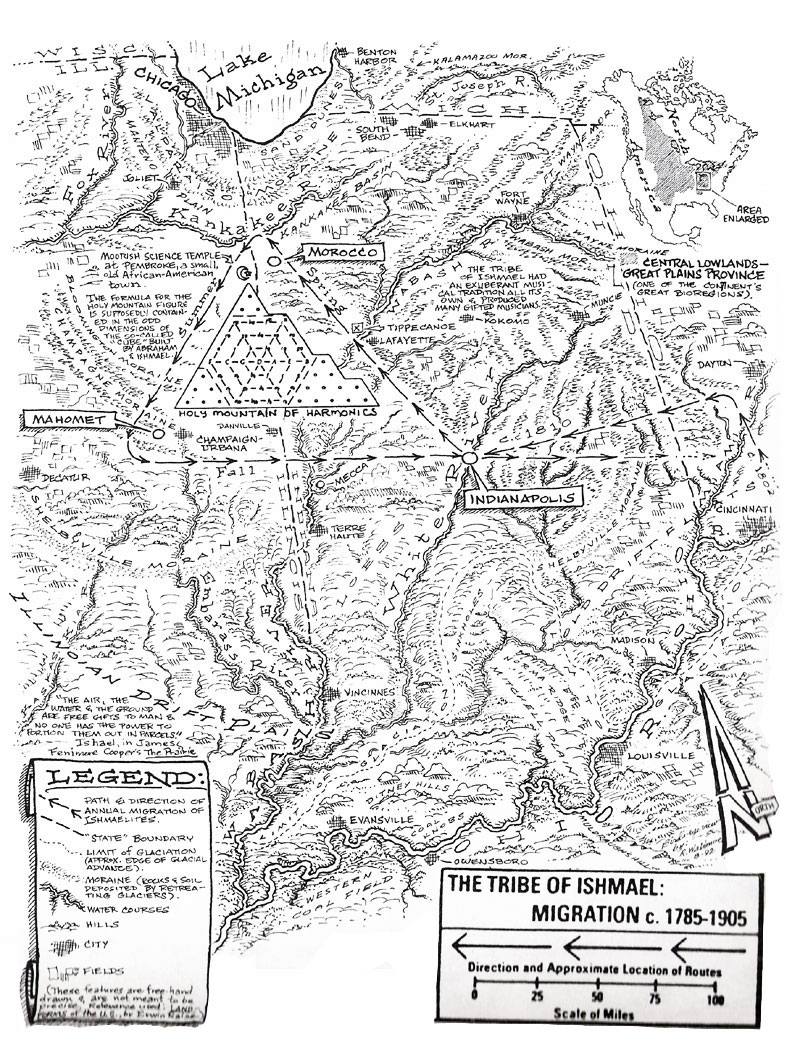E) Tribe of Ishmael
The Tribe of Ishmael, or Ishmaelites, was a tightly knit nomadic community of African, Native American, and "poor white" descent, estimated to number about 10,000. Fugitives from the South, they arrived in the central part of the Old Northwest at the beginning of the nineteenth century, preceding the other pioneers. After a century of fierce culture conflict with the majority society, the tribe was forcibly dispersed. (98)
The earlier migrations of the tribe had been involuntary, but they now pursued a nomadic way of life as a central feature of their distinctive culture. Their annual migratory route was northwest from Indianapolis to the Kankakee River south of Lake Michigan, from there south through eastern Illinois to the vicinity of Champaign-Urbana and Decatur, and finally due east, back to Indianapolis. This triangular route is about 350 miles as the crow flies. Every spring many hundreds of small carts set off, filled with children and the elderly, drawn by donkeys or horses (usually scrawny in latter years), the Ishmaelite men and women walking alongside. In the late spring (until "Indian Removal" in the north in the 1830s) there was joyful reunion with the Native Americans of the Kankakee. During the summer the tribe moved south, and when fall came they turned again to winter quarters. The migration was repeated every year for nearly a century. (101)
Already mentioned was James Whitcomb Riley's "Little Orphant Annie," who came to stay as a bound girl and terrorized her master's children with supernatural lore. That she was Ishmaelite is supported by her characterization as a "little gypsy" and "from a wild country settlement" in Riley's essay which amplifies the poem. (115)
A much more significant use of the Tribe of Ishmael in literature is not a regional work but a classic of the national literature, James Fenimore Cooper's novel The Prairie. The tribe, identified by name, is the center of action and theme. (116)
An Ishmaelite could be seen at one time as a childish but lascivious "Negro," a violent and savage "Indian," a shiftless and feeble-minded poor-white, and - most unspeakable - a mongrel product of the defilement of racial purity. This was a deadly mix that conjured up the nightmarish events of the war upon the Ishmaelites. (123)
To the majority people the shantytowns became a scandal, the annual migration an invasion by the "Grasshopper Gypsies," as they called them, and both were a cause of trouble for the authorities and alarm for the citizenry. (123)
It is appropriate - and not coincidental - that what came to take on world significance, a battery of genetic theories and eugenic proposals in the service of "scientific" racism, can be historically traced to the war on the Ishmaelites as one of its earliest sources. (129)
In 1905 a bill was introduced in the Indiana Legislature, and in 1907 the first compulsory sterilization law in the world was enacted by the state of Indiana. (130)
"The Ben Ishmael Tribe: A Fugitive "Nation" of the Old Northwest" (1977)
Hugo P Leaming

BACK // FORWARD // TABLE OF CONTENTS